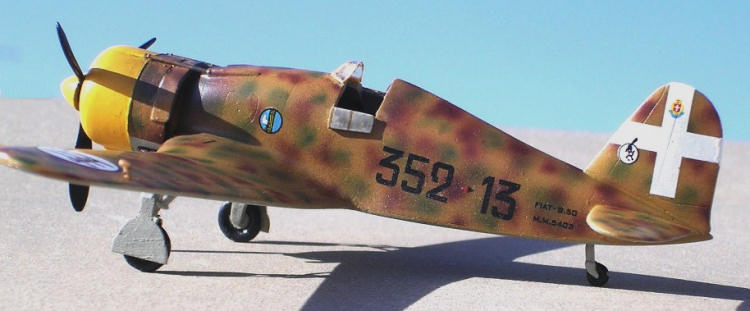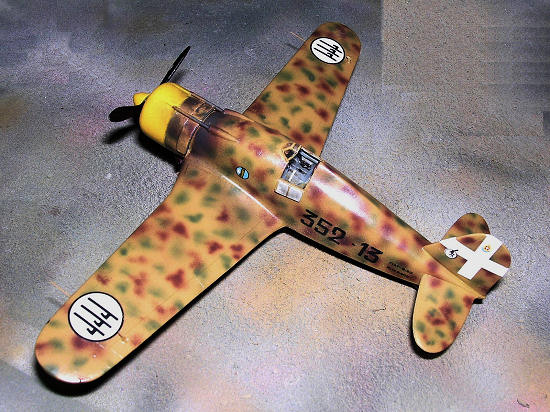
AML 1/72 Fiat
G50 Series II
| KIT #: | AML 72-007 |
| PRICE: | 27 Euro |
| DECALS: | Seven Options |
| REVIEWER: | Carmel J. Attard |
| NOTES: | Short run kit with resin and photo etch details. |

| HISTORY |
The Fiat G50 was the
first all-metal fighter in  tcomings
principally being lack of adequate visibility. The view from the cockpit was
inferior to that of the Bf-109 and even the Polikarpov I-16. The G50 was also
lightly armed with 12.7mm machine guns at a time when fighters then in service
were fitted with the more powerful cannons. Still the G50 had its share of fame
where a G50 series 1, FA-25 shot down 4 enemy aircraft and a G50 Series II, FA-1
shot down 9 aircraft besides other ace G50s while in service with the Finn AF
during the war.
tcomings
principally being lack of adequate visibility. The view from the cockpit was
inferior to that of the Bf-109 and even the Polikarpov I-16. The G50 was also
lightly armed with 12.7mm machine guns at a time when fighters then in service
were fitted with the more powerful cannons. Still the G50 had its share of fame
where a G50 series 1, FA-25 shot down 4 enemy aircraft and a G50 Series II, FA-1
shot down 9 aircraft besides other ace G50s while in service with the Finn AF
during the war.
| THE KIT |
Fiat
G50s, ‘series II’ (72-007) and the earlier release ‘series I’ (72-005) are neat
kits issued by
| CONSTRUCTION |
The first stages go
with assembling the cockpit area. The sidewalls detail structure is molded into
the fuselage halves while the cockpit floor; rear bulkhead and seat are in
cream-colored resin. The three-piece instrument panel is in brass, as also are
the trim wheel, throttle and rudder pedals. These items are all carefully
painted up making the cockpit look very close to what it should be in scale.
Once the assembly is inserted in the fuselage there will not be much visible. I
found best to assemble the fuselage halves together, the bulkhead is fitted to
the fuselage top part and the assembled cockpit is inserted in place from the
mid fuselage bottom opening.
carefully
painted up making the cockpit look very close to what it should be in scale.
Once the assembly is inserted in the fuselage there will not be much visible. I
found best to assemble the fuselage halves together, the bulkhead is fitted to
the fuselage top part and the assembled cockpit is inserted in place from the
mid fuselage bottom opening.
The 2-part radial
engine is injected in rows of cylinders, which made the required cleaning from
excess fining an easy task. The exhaust stabs are drilled before affixing them
to the cowling. Two spinner types are provided to suite the variant selected.
Propeller blade shape is accurate but required cleaning of each blade at their
periphery. The kit also has alternative tail fin and rudder units depending if
one makes the Italian or Finn version. Two measured hollow metal tubes were cut
and fixed to the nose deck.
Tail planes have a pair of dowels to slot inside the fuselage. The holes needed to be chased with a 2mm drill. I like the fabric texture on the elevators and care was made to preserve it. The main planes come in three pieces, a one piece lower and two upper halves. Ejector pin stabs on the inner face have to be removed first as these interfere with fixing the wing parts together. The leading edges of the wings are also on the thick side, which required a little scraping with a flat E-xacto blade to improve the overall thickness in this area. Wheel wells lacked detail and it is left to one’s research and reference to enhance this area. Merging the wing to the fuselage is not a straightforward job and some adjustment was needed followed by careful fairing with a little filler.
| COLORS & MARKINGS |
I elected to do
the Italian scheme for the G50. Markings are those of 320 Squadriglia.
The aircraft is ochre with verde and terracotta mottle on upper
surfaces and grigio azzurro undersurfaces while the codes 352-13 are black.
The cowling is yellow. T his I gave a white undercoat and then airbrushed the
yellow over it. After masking the cowling and the front of engine and the
open cockpit, I applied the Italian yellowish brown to all upper surfaces
then added mottle in red brown and olive green in all cases using Humbrol
brand. The undersurfaces were light blue gray and the upper camouflage
overlapped slightly like the full scale G50. The fin insignia of 51 Sturmo
depicting a black cat trapping three mice superimposed on a white background
disc, are a separate decal item which is attached to the fin after fixing
the white cross in place first. The white rudder cross is by no means
standard in shape and size. This had an arm extended to reach the leading
edge of the fin. The decals are printed by Propagteam and are thin and
excellent register.
his I gave a white undercoat and then airbrushed the
yellow over it. After masking the cowling and the front of engine and the
open cockpit, I applied the Italian yellowish brown to all upper surfaces
then added mottle in red brown and olive green in all cases using Humbrol
brand. The undersurfaces were light blue gray and the upper camouflage
overlapped slightly like the full scale G50. The fin insignia of 51 Sturmo
depicting a black cat trapping three mice superimposed on a white background
disc, are a separate decal item which is attached to the fin after fixing
the white cross in place first. The white rudder cross is by no means
standard in shape and size. This had an arm extended to reach the leading
edge of the fin. The decals are printed by Propagteam and are thin and
excellent register.
| CONCLUSIONS |
 This was my fourth
G50 built, two of which are
This was my fourth
G50 built, two of which are
If you would like your product reviewed fairly and quickly, please contact me or see other details in the Note to Contributors.